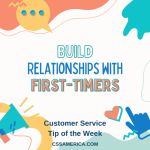
Want to create Service Excellence in your organization? Have a vision, then paint the picture of that vision. It’s easier to create something if you can visualize it first, so let’s Van Gogh a Vision.
Excellent customer service is delivered in a courteous manner. Courtesy comes through when employees are pleasant, they smile, they use the basics of “please” and “thank you,” the basics of “yes, sir” and “yes, ma’am.” Courtesy comes through when we are polite, and we have a caring tone about us.
Service Excellence is also delivered with respect, and customers nowadays want respect. So, what does respect look like? Respectful customer service is delivered in such a way that our body language, our smiles, how we say things, our attentiveness to the customer, and the phrases we use – they all tend to put the customer in the light of being more important than our co-worker, more important than our paperwork, more important than any task we have in front of us.
And if you look at Service Excellence from the perspective of you being a consumer, think about what makes an organization appear to have excellent customer service.
You usually know you are experiencing great customer service when the organization seems to go above and beyond the basics for you. They anticipate your needs. They greet you up front and show appreciation on the backend. They are responsive to the voicemail and e-mail messages. They are responsive to your needs. They tell you what to expect, and then they do what they say they are going to do.
Finally, to Van Gogh the Vision, look at organizations that have the reputation of being great at customer service – Disney, Chick-fil-A, and FedEx, for example. What do they do? They are consistently good. They are accurate. They are quick. You can trust their timeliness. They try to create an experience for the customer, not just a product. They have key core mission and vision statements so that everybody knows why they exist and where they are going. These are organizations that truly care about their customer, realizing if we convey that caring and meet their needs, then we will have the best chance possible of keeping that customer.
Van Gogh your Vision of Service Excellence.
Signup for FREE Tips! Contact Us More Resources for You Visit Our Home Page























